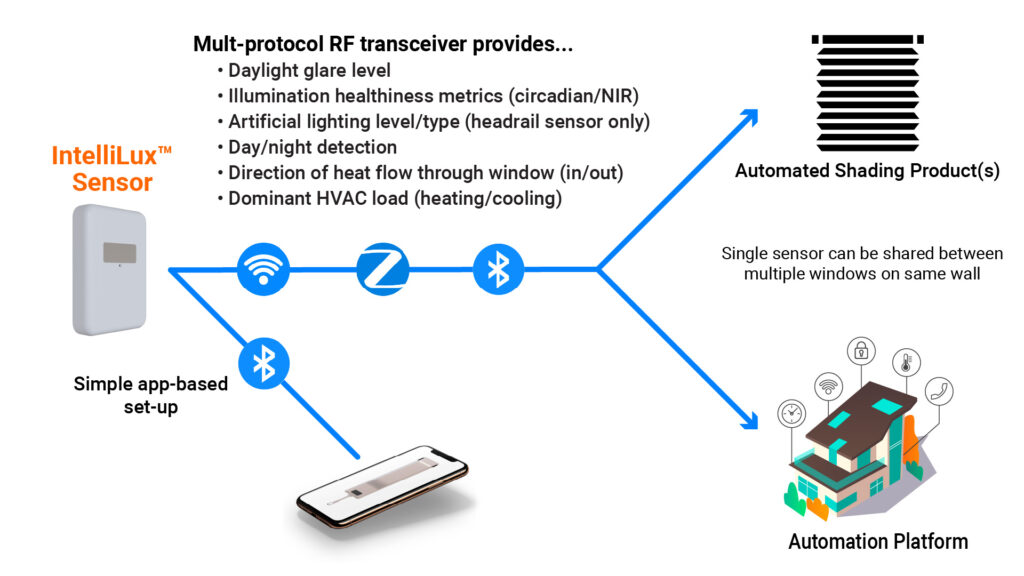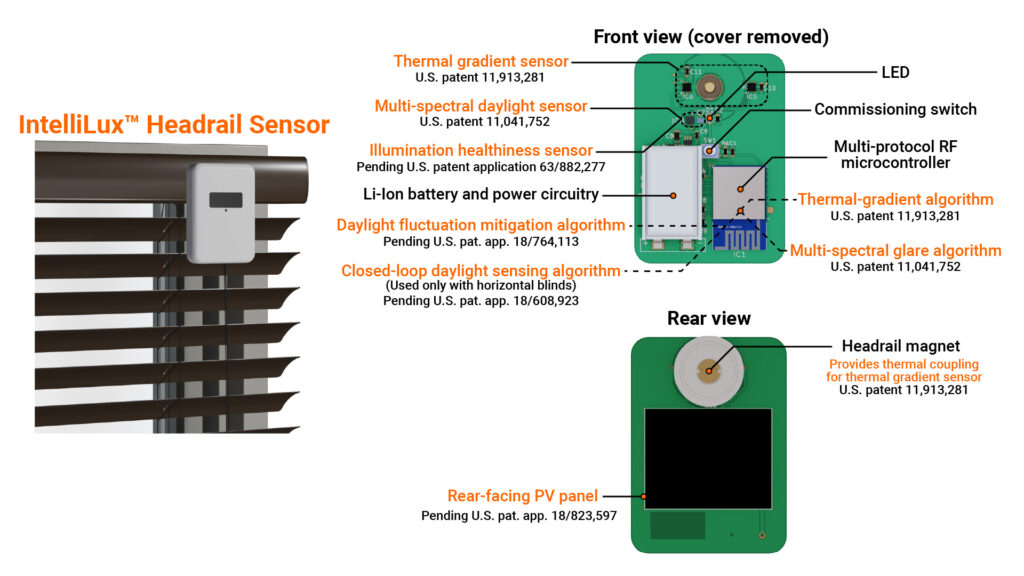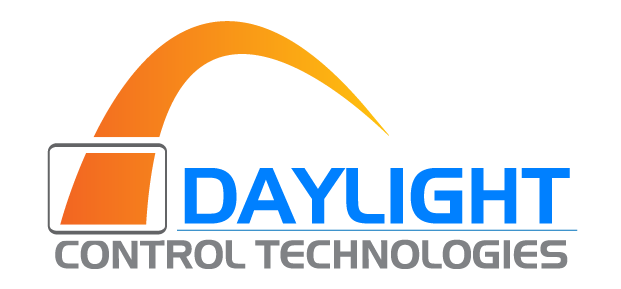IntelliLux™
the smartest smart sensors for automated shading

IntelliLux™ Sensors…
IntelliLux™ Sensors Unlock the Full Potential of Automated Shading
Two of the most valuable potential benefits of automated window shading are responsive daylight control and responsive thermal control:
- Responsive daylight control automatically adjusts the shading to maintain a desired level of glare-free daylight. In addition to providing a more pleasant and ergonomically correct visual environment, it also typically doubles the energy savings achievable through daylighting. Responsive daylight control is the most valuable automated shading capability, but also so challenging to implement with conventional technology that it’s virtually non-existent in today’s buildings.
- Responsive thermal control automatically adjusts the shading to minimize HVAC energy consumption.
However, few automated shading products offer these capabilities—and those that do typically require integration with lighting and HVAC systems, as well as significant time and effort to set-up the desired behavior. Even then, the results can be disappointing:
- Responsive daylight control is often unsatisfactory because it’s hard to reliably sense daylight glare with conventional sensors, and it’s hard to balance responsiveness against the need to avoid excessively frequent shading adjustments. In fact, when systems do offer responsive daylight control, it’s often so annoying that it’s turned off by the building occupants.
- Responsive thermal control often falls short of the full HVAC savings possible with automated shading. That’s because a window can be actually gaining heat while the building is losing heat, and vice versa—and conventional systems don’t respond to the actual heat flow through a window.
Our IntelliLux™ sensors overcome these challenges, enabling any automated shading system to provide state-of-the-art responsive daylight and thermal control capabilities.
Thanks to patented and patent-pending innovations, they do two things conventional sensors can’t do:
- They reliably sense admitted daylight as humans perceive it (and not just irradiance like conventional light sensors)—without any special requirements on sensor location or shielding, and while ignoring fluctuations due to moving clouds.
- They sense the actual heat flow through the building envelope, and not just temperature like conventional sensors. Their outputs indicate the instantaneous direction of the heat flow (whether the window is gaining or losing heat) as well as the daily average direction of the heat flow (whether the predominant HVAC load is for heating or cooling). This enables an automated shading system to achieve the maximum possible energy savings without need for integration with the HVAC system.
In addition, one of our two IntelliLux™ sensor variants can sense the healthiness of the ambient illumination. Specifically, it incorporates our TempoLux™ sensor technology, which senses the irradiance in the critical circadian-blue and Near-InfraRed NIR) spectral bands and provides actionable health-and-wellness metrics and enabling human-centric shading and lighting automation.
Thanks to these capabilities, IntelliLux™ sensor technology can enable a conventional automated shading product to provide the same kind of advanced, sensor-based shading automation provided by our IntelliBlind™ smart miniblind actuator.
IntelliLux™ Sensor Variants
The IntelliLux™ sensor technology can be integrated into an automated shading product like IntelliBlind™, or it can be packaged as a remote sensor that can be used to add advanced shading capabilities to other automated shading products.
We’ve developed reference designs for two such remote sensors: the IntelliLux™ Headrail Sensor for use in a closed-loop daylight control configuration, and the IntelliLux™ Window Sensor for use in an open-loop daylight control configuration:

Both provide all the information necessary for a wireless automated shading product or system to perform state-of-the-art responsive daylight and thermal control:

The IntelliLux™ Headrail Sensor
The IntelliLux™ Headrail Sensor adds advanced closed-loop responsive daylight and thermal control capabilities to any automated shading product or system with wireless connectivity.
Closed-loop daylight control involves sensing the daylight on the interior side of a shading device. In theory, closed-loop daylight control is simpler to implement than open-loop control, which involves sensing the daylight on the exterior side of a shading device and then inferring the level of admitted daylight. Closed-loop operation also generally provides more accurate and reliable regulation of a process variable.
Unfortunately, closed loop daylight control just isn’t practical with conventional sensor technology:
- Unless the sensor is positioned to “see” the incoming daylight from the same perspective as the room occupants, its output can be decorrelated with the perceived daylight level, degrading the perceived effectiveness and value of the daylight control. This decorrelation is especially bad when the shading device is a horizontal blind (which is otherwise the most cost-effective shading device for daylight control), or in the presence of direct sunlight when the sun is low on the horizon. Unfortunately, it’s generally not feasible to position a sensor to avoid the decorrelation problem.
- Conventional sensors respond to artificial as well as natural light. Therefore, either the sensor must be positioned and shielded to avoid artificial light, or the artificial lighting level must be known and subtracted from the sensor output. Either approach complicates system implementation, and both further degrade the effectiveness of the daylight control.
- As with open-loop control, it’s difficult for a closed-loop daylight control system to balance responsiveness against the need to avoid excessively frequent shading adjustments.
Our IntelliLux™ Headrail Sensor leverages three innovations to overcome the unique issues associated with closed-loop daylight sensing:
- Our multi-spectral sensing technology (U.S. patent 11,041,75) senses incipient daylight glare far more effectively than conventional sensors. The version used in our Headrail sensor is also insensitive to artificial illumination, eliminating the need to shield the sensor from artificial light—or to compensate its output with the known lighting level—in closed-loop applications.
- Our closed-loop daylight sensing algorithm for horizontal blinds (pending U.S. patent application 18/608,923) enables effective sensing of the admitted daylight regardless of the sensor’s location relative to the blind.
- Our daylight fluctuation mitigation technology (pending U.S. patent application 18/764,113) enables the sensor to ignore sustained fluctuations due to moving clouds while still responding quickly to isolated changes in the daylight level.
In addition, our IntelliLux™ Headrail Sensor incorporates our TempoLux™ illumination-healthiness sensing technology (pending U.S. patent application 63/882,277) to enable human-centric shading automation to maximize circadian rhythm reinforcement and healthy Near-InfraRed (NIR) exposure.
Finally, our IntelliLux™ Headrail Sensor also incorporates our thermal gradient sensing technology (U.S. patent 11,913,281) to sense the actual energy flow through the window, as well as our modular headrail-mounted power system technology (pending U.S. patent application18/823,597) to integrate a photovoltaic panel large enough to support low-latency WiFi connectivity.

The IntelliLux™ Window Sensor
The IntelliLux™ Window Sensor adds advanced open-loop daylight and thermal control capabilities to any automated shading product or system with wireless connectivity.
Most (if not all) of the very few daylight control systems currently in use are open-loop systems because closed-loop control just isn’t practical with conventional sensor technology. However, conventional open-loop daylight control also suffers from significant limitations:
- The output of a conventional daylight sensor often isn’t a good analog for the perceived daylight level. That’s particularly true with direct sunlight when the sun is low on the horizon; this can cause severe glare despite a relatively low irradiance. The most sophisticated conventional systems attempt to compensate for this by factoring-in the known position of the sun, but that complicates implementation and set-up.
- As with closed-loop control, it’s difficult for an open-loop daylight control system to balance responsiveness against the need to avoid excessively frequent shading adjustments.
Our IntelliLux™ Window Sensor leverages three innovations to overcome the unique issues associated with closed-loop daylight sensing:
- Our multi-spectral sensing technology (U.S. patent 11,041,75) senses incipient daylight glare far more effectively than conventional sensors.
- Our daylight fluctuation mitigation technology (pending U.S. patent application 18/764,113) enables the sensor to ignore sustained fluctuations due to moving clouds while still responding quickly to isolated changes in the daylight level.
In addition, our IntelliLux™ Headrail sensor incorporates our thermal gradient sensing technology (U.S. patent 11,913,281) to sense the actual energy flow through the window:

